Charaka Shareera Sthana 5th Chapter Purusha vichayam Shareeram
5th chapter of Charaka Shareera sthana deals with “the individual as an Epitome of the Universe”. The chapter name is Purushavichayam Shareeram.
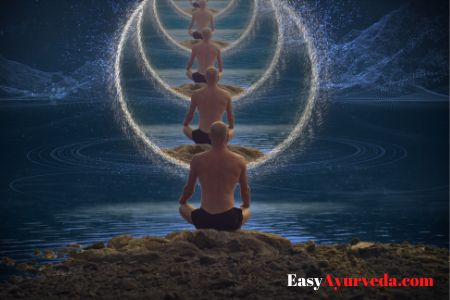
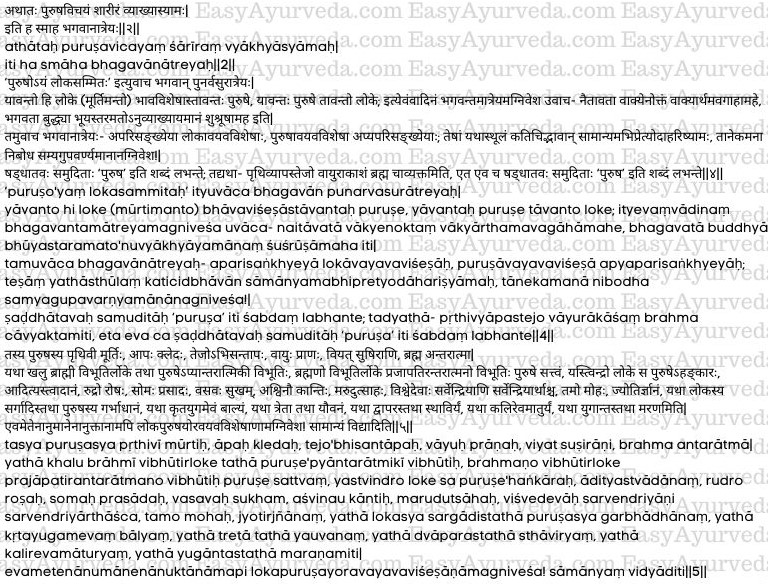
Read – Panchamahabhuta: Application, Areas of Utility in Ayurveda treatment
Table of Contents
Loka Purusha Samya Vada
Now we shall explore the chapter dealing with “the individual as an Epitome of the Universe” as conducive to the understanding of the body. Thus said Lord Atreya [1-2]
Individual – an epitome of universe
An individual is an epitome of the universe as all material and spiritual phenomena of the universe are present in the individual and all those present in the individual are also contained in the universe.
“Thus said Punarvasu Atreya. Then Agnivesha enquired, “We cannot grasp the idea contained in this aphoristic statement from your enlightened self. “Lord Atreya replied, “Innumerable are the specific parts of the universe and so are innumerable the specific parts of an individual. I will explain to you some of the gross phenomena common to the universe a well as the individual, listen to me attentively Agnivesha. Purusha is nothing but the combination of the six Dhatus, i.e. Prthvi – earth, Jala – water, Teja / Agni – fire, Vayu – wind, Akasha – ether and Brahman – the soul. [3-4]
Read – Atma – The Soul: Types, Life Cycle
Identity of factors in individual with those of universe
Prthvi constitutes the form of man
Jala – constitutes the moisture
Tejas – constitutes the heat
Vayu – constitutes the life element / élan Vitae
Akasha – constitutes all the porous parts and
Brahman – constitutes the internal Soul
Identity of the various universal phenomena as present in the individual is given below:
| Universal Phenomena | Corresponding phenomena in man | ||
| 1,2 | Potentially of the Brahman symbolized by Daksha Prajapati | 1,2 | Potentially of the internal Soul symbolized by the mind |
| 3 | Indra | 3 | Ahamkara (ego) |
| 4 | Aditya | 4 | Accumulation |
| 5 | Rudra | 5 | Anger |
| 6 | Soma (Moon) | 6 | Pleasure |
| 7 | Vasus | 7 | Happiness |
| 8 | The Asvins | 8 | complexion |
| 9 | Marut | 9 | enthusiasm |
| 10 | Visvedeva | 10 | All the senses and objects of senses. |
| 11 | Tamas (darkness) | 11 | Ignorance |
| 12 | Jyothi (light) | 12 | Knowledge |
| 13 | Beginning of creation | 13 | Impregnation |
| 14 | Krta age | 14 | Childhood |
| 15 | Treta age | 15 | Youth |
| 16 | Dvapara age | 16 | Middle age |
| 17 | Kali age | 17 | Old age |
| 18 | Deluge | 18 | Death |
The above description is given only by way of illustration. There are many other phenomena common to the universe and man which can be understood by inference, O! Agnivesha. [5]
Read – Paramatma – The Greater Soul: Difference Between Jivatma And Ishwara
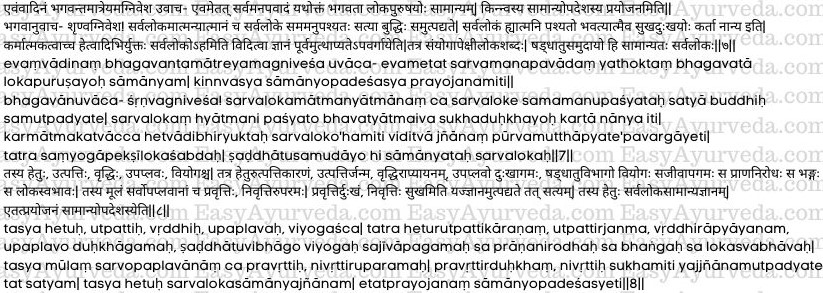
Utility of the knowledge of the Individual as an epitome of Universe
Agnivesha again asked Lord Atreya, “All that you have said about the identity of phenomena present in the universe and man is true without any exception. But then how is this statement relevant in the context of medicine?”.
Lord Atreya replied, “Listen to me O! Agnivesha. One who sees equality in the entire universe in his own self, and his own self in the entire universe is in possession of true knowledge. Such a person experiencing the entire universe in his own self believes that none but his own self is responsible for happiness and miseries. The individual self being subordinate to his own action indulges in various activities only when impelled by hetu (cause) etc. As soon as he realizes his identity with the entire universe, he is in possession of true knowledge which stands him in good stead in getting salvation.
The term “Loka” implies here a combination of several factors. A congregation of six Dhatus constitutes the entire universe consisting of all creatures. [6-7]
Read – Moksha – The Ultimate Spiritual Liberation
Miseries and happiness of the Individual
An individual has a Hetu (cause), Utpatti (birth), Vrddhi (growth), Upaplava (Decay) and Viyoga (dissolution). Hetu is the cause of manifestation, Utpatti is birth, Vrddhi is growth, Upaplava is insulation or attainment of the natural state.
His attachment to the various actions constitutes a causative factor of all his miseries and detachment a causative factor of cessation of all miseries. Realisation of the fact that ‘attachment leads to miseries’ and ‘detachment leads to happiness’ is considered as the real knowledge.
This knowledge can be achieved only by virtue of the realisation of the identity of the universe and man. This is the object of instruction relating to the identity of the universe and man. [8]
Read – 40 Ways To Attain Salvation As Per Ayurveda – Nivrutti
Cause of attachment and method of detachment
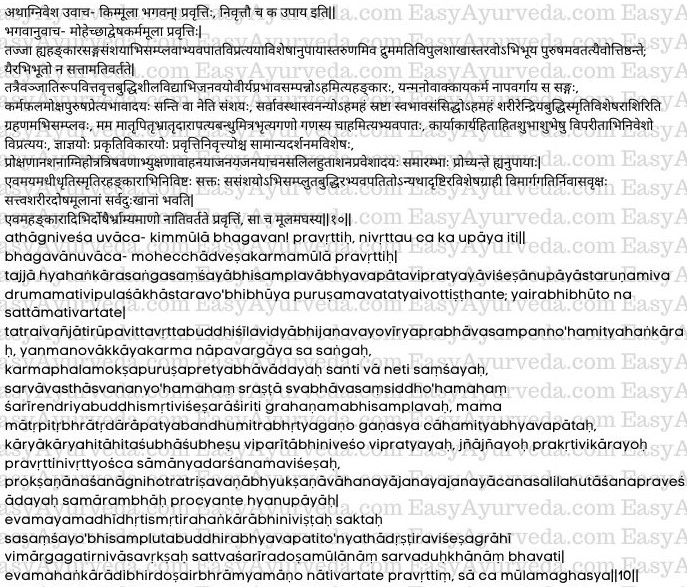
Thereafter Agnivesha asked, “What is cause of attachment and what are the factors responsible for detachment?” Lord Atreya said, “Attachment is caused by ignorance, desire, hatred and purposeful action. Ahamkara, Sanga, Samshaya, abhisamplava, abhyavapata, Vipratyaya, avisesa and Anupaya also arise out of attachment.
These factors arising out of attachment would encroach and envelope an individual, overcome (dominate) him and become all powerful just like a big tree with many long branches dominate (overcome) and overgrow a small tree and become all powerful and encroaching. These factors engulf an individual to such an extent that he would find it impossible to free himself from the clutches of ignorance etc worldly habits.
Read – Pravritti – Attachment, Meaning, Causes, Effects of Attachment
Ahamkara represents an egoistic feeling. It is to tell ‘I belong to the best clan, I am endowed with the best of appearance, wealth, goodness, character, great intelligence, great conduct, good family / lineage, youth, valour / potency and influence.
Sanga represents that mental, vocal or bodily action which is not conducive to the attainment of salvation.
Samsaya stands for doubt regarding the existence of the result of the past action, salvation, soul, life after death, reincarnation / rebirth etc.
Abhisamplava – includes imbibing or establishing the other’s quality. It can be considered as the mistaken perception of identifying one’s soul with one’s body. Example – making statements like ‘in any given situation, I am second to none (I am the ultimate)’, or ‘I am the creator of everything’ or ‘I am a self established and accomplished person by nature’ or ‘I am a combination of body, sense organs, intelligence and memory’.
Abhyavapata – It includes showing possessiveness towards the things indifferent to self and which doesn’t belong to self. It is a sense of ownership. Example – ‘telling I have father, mother, wife, progeny, relatives, friends and servants and I belong to them’.
Vipratyaya – includes ‘contrasting belief’ like considering a desirable act as undesirable, something beneficial as non-beneficial or harmful and the acts and things which are auspicious as inauspicious and vice versa.
Avishesha – is lack of distinction when a person becomes incapable of making distinction between consciousness and unconsciousness, nature and its modifications, attachment and non-attachment (detachment).
Anupaya – includes religious rituals which are inefficient. These rituals include –
- Proksana – consecration
- Anashana – fasting / starvation
- Agnihotra – oblation to the fire
- Trishavana – performing sacrifice thrice a day while worshiping soma
- Abhyukshana – wetting
- Aavahana – invocation
- Yajana – leading or guiding sacrificial rituals
- Yajna – fire sacrifice
- Yachana – begging
- Salila hutashana praveshah – entering into water and fire
The person becomes an abode of all miseries and is also trapped in the vicious cycle of life and death and will not attain salvation if –
- he is devoid of intellect, restraint and memory
- is egoistic and self centred
- is attached to objects, persons and actions
- is incapable of distinguishing between what is good and what is bad
- is unable to distinguish between self (soul) and the physical body
The well being of the purusha – individually and also socially is the source of salvation from all kinds of miseries which eventually is also the ultimate goal of Ayurveda.
Read – Treatment For Excess Desires – Naishtiki Chikitsa
Salvation and ways of attaining it
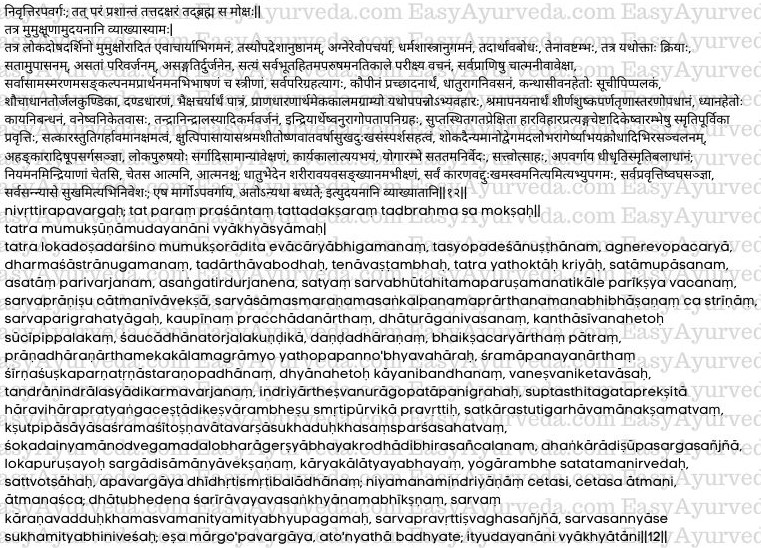
Read – Sadvritta In Ayurveda – Code Of Conduct For Healthy Life
Detachment is salvation
It is Para (absolute)
It is Prasanta (Serene)
It is Akshara (immutable)
It is Brahman
It is Moksha (Emancipation)
We shall now explain the ways and means of getting salvation. From the very beginning the following constitute the conduct and behavior of a man who has realized the defects of the world and who is desirous of getting salvation:
- Visit to the preceptor i.e. the one imparting instructions on salvation
- To carry out his instructions
- Exclusive service to the fire
- To follow the prescriptions of religious scriptures
- To understand the meaning of such scriptures
- To have patience as prescribed in scriptures
- To perform acts as prescribed in scriptures
- Devotion to the noble
- To keep away from the company of the wicked
- Dissociation with the wicked
- To make statement which are true, useful for all creatures and not harsh; such statements should be made after proper examination at appropriate time
- To look at all creatures as if they represent himself
- Avoidance of all contacts including remembering, thinking, requesting and talking with woman
- Avoidance of all acquisitions
- Wearing of Kaupina (loin- cloth)
- Wearing of saffron coloured dress
- Having a needle case for the sewing of robe
- Having a water pot for maintaining cleanliness
- Having sacred Danda (stick)
- Having sacred begging bowel
- Taking prescribed food only once a day just to preserve his life
- Having a bed consisting of dry leaves, grass etc, just for rest
- Use of Yogapatta (a wooden resting plank) for meditation
- Living in the woods without having any home
- Avoidance of drowsiness, sleep, laziness etc
- Avoidance of attachment and hatred towards the objects of sense organs
- Initiating actions like sleeping, staying, going, seeing, eating, enjoying, movement of all various limbs (with a sense of recollection of the nature of his own soul etc)
- Maintenance of serenity in the face of honour, praise, criticism and insult
- To stand the onslaught of hunger, thirst, efforts, labour, cold, heat, wind, rains, happiness, miseries and sensory contacts non-disturbance by sorrow, miseries, respect, perturbation, vanity, greed, attachment, envy, fear, anger etc
- To view pride etc, as disturbing factors
- To remember the identical nature of creation etc, of the self and the universe
- To be afraid of postponing actions conducive to salvation
- To have confidence in yogic practices
- To be optimistic about spiritual attainments
- To direct intelligence, patience, memory and strength for salvation
- Restraint of sense organs in the mind (so as not to allow them to move towards external objects) restraint of the mind in the self and finally of the self in himself
- Realisation of different organs of the body as composed of Dhatus (tissue elements)
- To realize that belonging to self
- To view all attached actions as sinful and
- To consider renunciation as a potent factor for happiness
- This is the gate way to salvation. One finds himself in bondage otherwise. Thus the ways and means to salvation are explained. [11-12]
Read – 16 Factors To Watch For A Healthy Mind And Body
Thus it is said
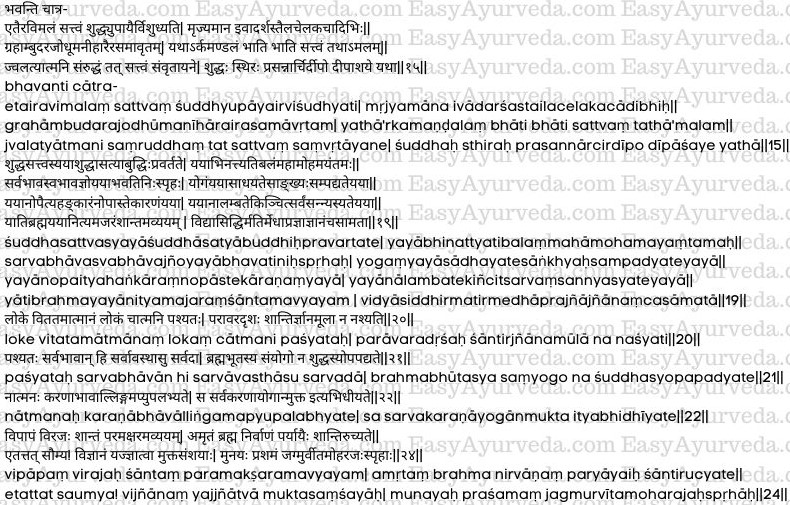
The vitiated mind gets purified by these purifying factors as a mirror is cleaned with the help of oil-cloth, hair etc. Just like the Sun dazzles when it is not covered by Rahu, cold, dust smoke and fog, the mind too shines when it is in a state of purity. While restrained in the soul with his movement obscured, the mind, pure and stable, shines just like the lamp shines with bright flame in the lamp case. [13-15]
A person with his mind pure, is in possession of true wisdom
- which dispels the excessively thick darkness caused by ignorance,
- which brings about detachment and knowledge about the nature of all things,
- which is conducive to the attainment of yogic power,
- which renders an individual wise,
- which brings about freedom from vanity and detachment from the causative factors of miseries,
- which renders an individual free from hopes,
- which brings about renunciation and
- which serves as a means to attainment of Brahman, the Eternal, Immutable, Tranquil and Indestructible
It is this wisdom which is known as Vidya (learning), Siddhi (accomplishment), Mati (Jnana (knowledge). [16-19]
Read – Mind – Qualities, Functions, Doshas As Per Ayurveda
Effect of identification of the individual with the Universe
If one realises himself as spread in the entire universe and the entire universe spread in him, he is indeed in possession of transcendental and worldly vision. His serenity of mind based on wisdom does never feed away. [20]
Cessation of contacts
When a person visualizes the presence of everything in all situations, he is one with Brahma, the absolute. He does no longer have any contacts with, the various and sinful acts. [21]
Liberation from bondage
It is not possible even to characterize the liberated Soul because he has no contact whatsoever with mental or other sense faculties. So, being detached of all sensory contacts, he is considered to be a liberated Soul. [22]
Synonyms of “Santi (Liberation)”
Shanti (Liberation) is synonymous with Vipapa (free from sinful acts), Viraja (free from attachments), Santa (serene), Para (absolute), Aksara (indestructible), Avyaya (immutable), and Amrta (extinction of all miseries). This is spiritual knowledge after knowing which, the sages get freedom from all doubts, ignorance, attachment and desires attain the state of Prasama (absolute tranquillity) i.e. salvation. [23-24]
Read – Money, Ayurveda, Spirituality – How To Strike Perfect Balance?

To sum up:-
In this chapter with ‘the individual as an epitome of the universe’, the sage has described the following topics:
The common origin of the universe and the individual together with purpose behind the knowledge of such a common knowledge.
Attainment of the pure state of the mind
Virtuous intellect conducive to the attainment of salvation and
Salvation [25-26]
Thus ends the fifth chapter dealing with “the Individual as an Epitome of the universe as conducive to the understanding of the body” of the Sharira section of Agnivesha’s work as redacted by Charaka. [5]










